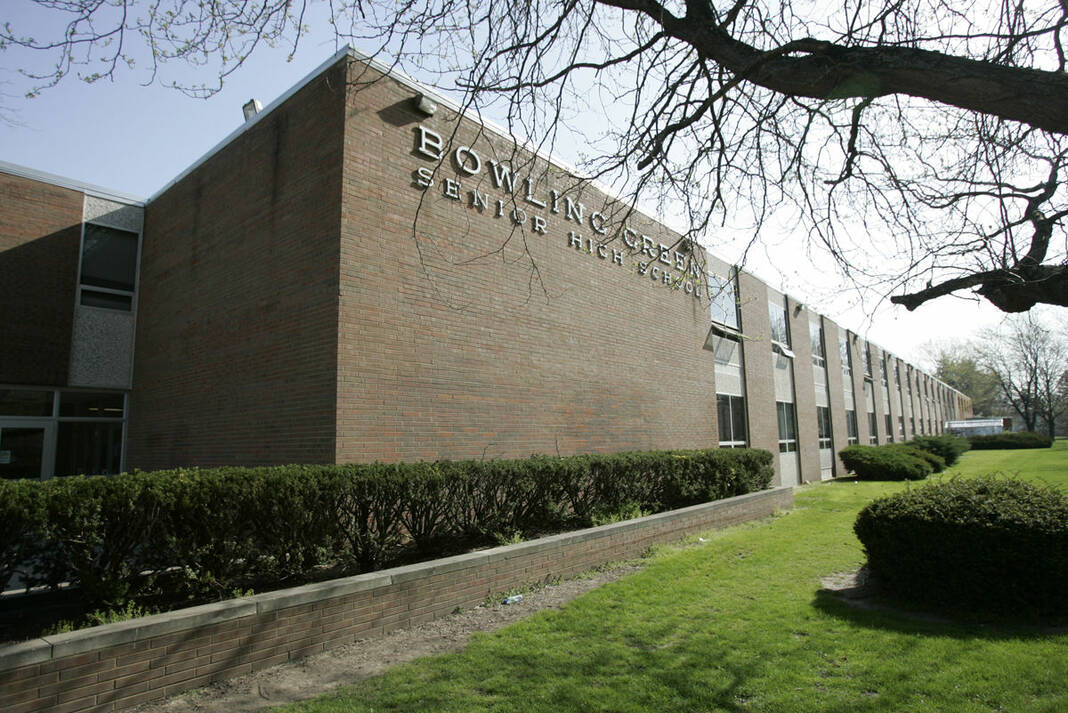
Bowling Green City Schools voters have rejected a combined income-property tax proposal to fund a new high school.
Unofficial results from Tuesday’s election show 4,960 (47.80%) favored and 5,417 (52.20%) opposed the request for a combined bond issue/income tax to fund a new high school and renovations to the existing building.
“I am devastated as a six-year board member who has worked to move this district forward and we can’t get the community to support us,” said school board President Jill Carr. “This is about the future of Bowling Green as a community and the education of our students.”
Board member Ginny Stewart agreed.
“The voters who made the decision to deny the school district of a new high school have not only hurt the future of the district, but their decision will have long-range ramifications to the future of Bowling Green. This is sad and so short-sighted,” she said.
“I agree with those that say this is an issue that is affecting the entire community,” said Mayor Mike Aspacher.
He said he sees value in having a community conversation and asking what will be required to gain support of the city’s educational system.
“The city of Bowling Green does value education,” he said.
Aspacher graduated from Bowling Green High School in 1979 and has been in the building since with his children. He said it looks very much like it did when he was there in the 1970s.
“The community has recognized the need to address our school facilities, now we need to understand what is the barrier to a plan that will be broadly supported by the community,” he said.
Superintendent Francis Scruci also wondered what that barrier was. He said the reasons given by the public for not supporting new buildings — going back nearly five years — have been they don’t like the plan, they want to keep community elementaries, they didn’t want to use all property tax to fund a school, and now inflation.
“We’ve continued to evolve and try to determine what the community will support and meanwhile our costs go up and our facilities continue to deteriorate,” Scruci said.
He said despite any kind of upkeep and maintenance, the buildings are like a house: old houses get older.
“I think right now, the biggest question is what this community will support,” Scruci said.
In the meantime, Bowling Green City Schools has great teachers who will continue to focus on the kids, he said.
Funding for the $70 million project was to be split 70% property tax and 30% income tax.
A district facilities advisory committee recommended a new high school at a community forum in March. Ninety-five percent of the committee agreed that building a new high school was the way to go.
“The effort this time was to have the entire recommendation come from the community,” said board Vice President Ryan Myers. “At the end of the day it wasn’t what the voters wanted.”
Scruci said there was a good community representation in that committee that helped determine which project would get the most support, and even that didn’t work.
“I’m sorry that the levy failed. We do definitely need a new building,” said Richard Strow, who was a spokesperson for the facilities advisory committee.
He said he hopes the work of the committee, which met for nearly a year, won’t be in vain.
“Maybe with some new leadership, the public will consider this,” Strow said. “I hope that the board reflects upon this and makes some changes and I hope they do it soon so the community can move forward.”
When the focus leaves the kids and turns to adults, that’s where it gets muddy, Myers said.
“I don’t think any good leader that has 100% buy-in from anybody,” he said.
The goal of the campaign was to not have the community at war, as happened during previous bond requests, Myers said.
“I don’t think that’s good for anybody,” he said.
Tuesday’s ballot issue was a combination property tax and income tax. A 3.95-mill property tax would have collected $49 million for 30 years. A 0.5% income tax would have been collected for seven years then eliminated.
Combined, $119.76 million was estimated to be collected over the life of these two issues to pay for the principal, interest and maintenance of the building.
David Conley, with Rockmill Financial Consulting, had calculated the property tax would cost $136.39 annually for the owner of a home valued at $100,000. Someone with the district’s median income of $66,215 would pay $331 a year in income tax for seven years.
The high school was built in 1963 and is not handicap friendly and has lacked air conditioning until this year when mini-splits were installed.
There is one elevator that is not centrally located for use by a student who uses a wheelchair; science rooms are not properly equipped; steam pipes leak; and classrooms are too small to best serve teaching for the future with technology.
Tuesday’s results are the fourth time the district has been unable to get voter approval for funds for a new building.
Efforts to pass a bond issue for one consolidated elementary have failed in three attempts since 2017.
Two of those attempts also included funds for a new academic wing, gym and cafeteria at the high school.
The third request, solely for one consolidated elementary, lost by 32 votes in November 2019.
At that time, the estimated cost of the new school was $40 million. The ballot included a 0.25% traditional income tax that would have collected $20 million and a 1.6-mill property tax that also would have collected $20 million.
Myers said he thinks the community recognizes the need for new buildings.
“The one thing I think everyone knows (is) this is a problem that is not going to go away,” he said.
All results from the Wood County Board of Elections are unofficial and do not include provisional ballots cast.

